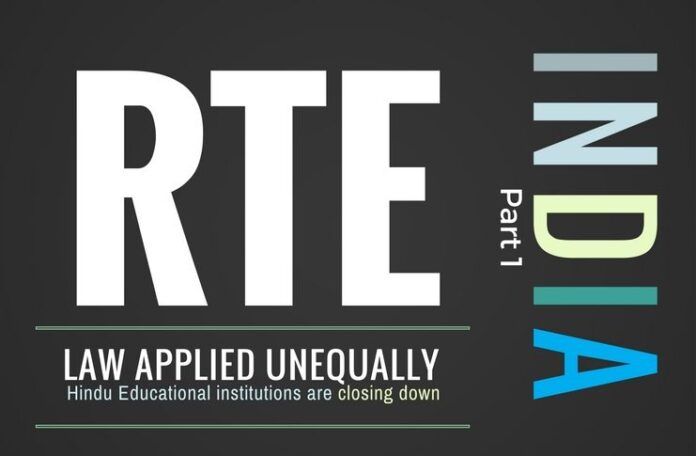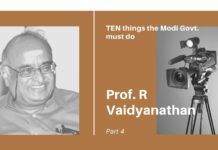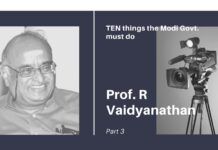
Law applied unequally
BJP’s continued apartheid against Hindus
- Why can’t I run schools with the same freedom given by law to a Christian?
- Why is the government taking money away from my temple and giving to a church?
- Why can’t my children get a scholarship from the government but crores of non-Hindu children can?
- Why are my festivals and practices denigrated or legally banned but Christian ones are not?
- Why does the government allow foreign NGOs funded by foreign money with ties to the Church to lobby for laws against me?
- Why does the government give money raised from my own taxes to pay my fellow Hindus to renounce our own religion?
Why has the BJP government at the center and in states continued to entrench the Hinduphobic laws, institutional infrastructure and political-economic incentives that hurt Hindus socially, politically, culturally and economically?
In 2014, Narendra Modi won an historical mandate from the Indian electorate. His victory was widely seen as a watershed moment due to his background as an unapologetic Hindu leader. His mass appeal was quite distinct from that of his predecessors’, including that of the only prior BJP prime minister Atal Bihari Vajpayee. All previous Indian prime ministers including Vajpayee had emerged from a broad spectrum of Nehruvian socialist-Hinduphobic ideology but Modi was seen as a departure from it. Two main pillars of Modi’s vote base were generally categorized as “Development” and “Hindutva” by analysts, representing constituencies that emerged around better governance and resistance to politically entrenched institutional Hinduphobia.
RTE forces Hindu run schools to subsidize 25% seats mostly from the schools’ own funds. This is a communal tax – a modern day jizya – on Hindus
Two years into the mandate, how has the Modi government actually performed? Has PM Modi lived up to the expectations raised by candidate Modi? The general consensus is that PM Modi has indeed performed exceptionally well in the areas of clean governance, foreign policy and economic stewardship. It is safe to assume that the Development constituency is satisfied with PM Modi. However, PM Modi has been a spectacular failure for the Hindutva constituency. Contrary to the shrill leftist rhetoric before and after the 2014 election, the Modi government has studiously stayed away from the pressing agenda of correcting historic injustices by the Hinduphobic Nehruvian elite towards Hindus. The resulting disappointment with PM Modi has been widespread on social media, particularly among his staunch supporters.
The RTE laws enacted by the UPA have wreaked havoc
-
The Right To Education (“RTE”) law is a draconian tool of Hinduphobic forces led by the Congress party as it is ruthlessly effective in reducing the market share of Hindu-run schools by unfairly tilting the playing field in favor of Church-run schools. Congress-led UPA put all its might into enacting this legislation in 2009 in order to strategically position the Church to acquire a monopoly in the education sector over time. Under existing constitutional framework and legal precedent in 2004, this law would have been clearly unconstitutional. However, UPA made it a strategic imperative to destroy Hindu participation in the education sector by going to the extent of overturning a Supreme Court judgment through a constitutional amendment in order to make it possible to enact this legislation.
-
RTE forces Hindu run schools to subsidize 25% seats mostly from the schools’ own funds. This is a communal tax – a modern day jizya – on Hindus. It is a financial confiscation of Hindu schools. Furthermore, the legislation creates many onerous requirements for Hindus to start or operate schools. These create many barriers to entry and competition specifically and only for Hindus. The playing field is tilted in favor of the church as The RTE simply does not apply to minority-run schools. Such imposition of a sectarian license-inspector-subsidy raj on Hindu schools is utterly destroying Hindus’ capacity to run schools. This is a clear violation of constitutional guarantees of freedom of religion and equal protection of the law provided to Hindus.
-
The law has been spectacularly effective in achieving its political purpose of weakening Hinduism against Christianity by destroying Hindu participation in the education sector. As thousands of Hindu-run schools have closed or face potential closure, the market share of Church-run schools has automatically gone up. Furthermore, as schools close, education – already highly scarce and valuable commodity in India – becomes even scarcer, which increases its value. Its high value can then be used powerfully by the church to induce conversions, especially among the poor and under-educated sections of Hindus. RTE has thus created a lethally effective economic stranglehold to push Hindus away from educating their children which is being ruthlessly leveraged by the church both to increase its market share of education sector and make education more valuable as an economic incentive to induce conversion.
-
Not only has the BJP government in center has done nothing to repeal it or fix its deeply Hinduphobic features, but its state governments such as the one in Maharashtra are zealously enforcing it at the detriment of Hindu schools. Why is this?
-
National Independent Schools Alliance indicates over 4,160 Hindu-run schools have closed, 7,796 Hindu-run schools have been served closure notices, and 11,950 Hindu-run schools face closure threat. Isn’t it utterly criminal to force schools to close in a country where education is such a desperately needed good? How does potentially closing over twenty three thousand schools advance PM Modi’s development agenda?
- A Brief History of the 93rd Constitution Amendment
- Explaining the 93rd Amendment to the BJP
For a history and analysis of the RTE legislation, see the following articles:
-
-
The anti-superstition law in Maharashtra targets legitimate Hindu practices such as those of aghori sects. In Karnataka, a bill is under consideration that proposes making practices such as “made snana”, “rituals that involve self-inflicted injuries such as hanging from a hook inserted into the body (sidi)” or “aghori or siddhubhukti” illegal. It is absolutely ridiculous that while Hindu groups and practices are targeted under these laws, the Foreign Minister of India attends Mother Teresa’s “canonization” which is based on a fraudulent “miracle”. This “canonization” is nothing but targeted propagation of superstition for mass conversion in India by the Roman Catholic Church. More routinely, church evangelists widely spread superstition by holding “faith healing” events for gullible people.
-
Why are such laws targeting legitimate Hindu practices merely because, seen from an Abrahamic lens, they appear superstitious? And why aren’t such laws used against church evangelists openly holding faith healing events and spreading other superstitions in Maharashtra? Isn’t Theresa’s canonization an act of superstition? Will the government of Maharashtra file a case against the Roman Catholic Church for spreading superstition by “canonizing” Theresa due to a “miracle” she performed?
-
Hindu practices such as Jallikattu, Dahi Handi, Nagapanchami, and others are being systematically targeted for annihilation, following the time-tested Christian strategy of targeting pagan rituals, festivals, gods, and symbols. Church inspired front organizations are busy using all instruments of power such as lobbying for legislation, filing cases in courts, media propaganda and so on to strike at the heart of Hinduism.
Why hasn’t the BJP government enacted any laws to protect Hindu traditions, culture and practices? If the UPA government could get Hinduphobic constitutional amendments and legislation like RTE passed even when it had no majority in the Lok Sabha, what is the BJP’s excuse not to pass laws to protect Hindus’ traditional culture from a sustained onslaught by Hinduphobic forces?
Can Hinduism survive the onslaught of Project Thessalonica?
Views Personal.
To be continued…
- Hinduphobia for minority votes? Concluding part - September 23, 2016
- Legalized Hinduphobia – RTE Law, hurts Hindus Part 1 - September 20, 2016











Powerful people in BJP are very dear and near Friends of Congress. Vote gathering is done by some prominent face and then power is enjoyed by lutyen’s gang. That gang is clearly has no interest in Nation or Hindus.